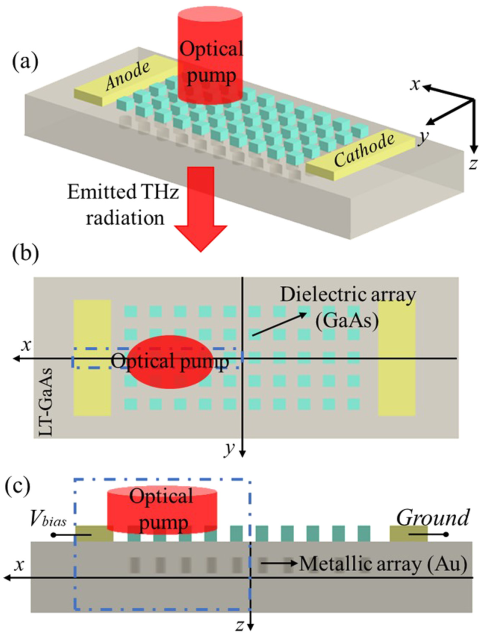Terahertz (THz) waves have the unique advantages in the applications of terabit wireless communication, chemical-fingerprint identification and space exploration, which can greatly reshape the living conditions in the coming decades. To bring these advanced applications to daily use, though, the strong THz sources are urgently required.
Among all the proposed THz sources, the THz-PCA is the most promising one due to its advantages of efficient, low-cost, compact, and broadband radiation. In the past few years, the performance of THz-PCA have been improved by incorporating plasmonic structures or dielectric metasurface. However, the ohmic loss and heat transfer of metal and the insufficient field enhancement of dielectric inevitably hinder the further improvement of THz-PCA.
A research team led by Prof. Dr. FAN Wenhui from Xi'an Institute of Optics and Precision Mechanics (XIOPM) of the Chinese Academy of Sciences (CAS) proposed a THz-PCA based on antireflection dielectric metasurfaces with embedded plasmonic nanodisks to address the above obstacles. The results were published in APPLIED OPTICS.
According the researchers, they used dielectric metasurface as an anti-reflection layer, which can improve the optical transmission for generating more photocarriers. As for insufficient field enhancement, they embedded plasmonic nanodisk into the substrate to enhance the local field for accelerating the electrons’ drift velocity.
It is worth to mention that the embedded plasmonic nanodisk has two unique advantages: (1) The damage threshold of the THz-PCA is barely affected: the incident light interacting with the nanodisk was weakened due to the absorption of substrate. (2) The ultrafast switching process of THz-PCA can be maintained: the direction of the photocarrier movement under bias voltage is toward the electrodes located at the substrate surface.
To verify the performance of designed THz-PCA, the simulation model was established via Maxwell’s equations for optical response as well as coupled Poisson’s equations and drift-diffusion equations for electrical response.
The simulated results indicate that the proposed THz-PCA is 4.9 times higher in photocurrent, 8.4 times stronger in the intensity of the radiated THz field, and 70.56 times enhanced in THz radiation power than that of the traditional THz-PCA.
The significant enhancement ensures the designed THz-PCA can improve the optical-to-THz conversion and has great prospects to promote THz technology based on THz-PCA.
This work was supported by the National Natural Science Foundation of China and Natural Science Foundation of Shaanxi Province.
The schematic of proposed THz-PCA. (Image by XIOPM)



